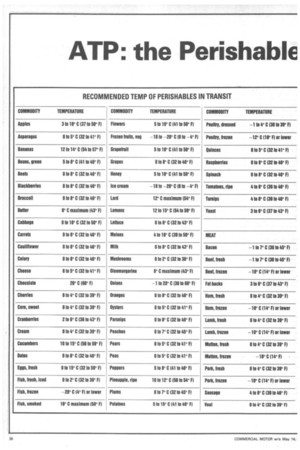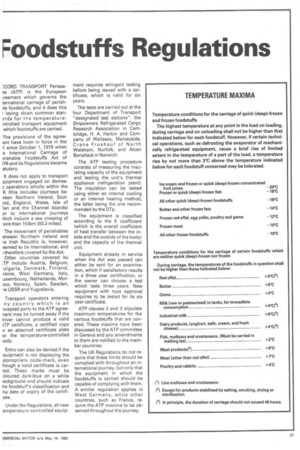ATP: the Perishable Foodstuffs Regulations
Page 28

Page 29

If you've noticed an error in this article please click here to report it so we can fix it.
:CORD TRANSPORT Perissaas (ATP) is the European Ireement which governs the ternational carriage of perishde foodstuffs, and it does this laying down common sten]rds for the temperatureintrolled transport equipment which foodstuffs are carried.
The provisions of the agreeent have been in force in the < since October 1, 1979 when e International Carriage of mishable Foodstuffs Act of 176 and its Regulations became atutory.
It does not apply to transport quipment engaged on domes c operations wholly within the K (this includes journeys beveen Northern Ireland, ScotInd, England, Wales, Isle of Ian and the Channel Islands) or to international journeys fhich include a sea crossing of lore than 150km (93.3 miles).
The movement of perishables etween Northern Ireland and le Irish Republic is, however, eemed to be international, and ; therefore covered by the Act. Other countries covered by ;TP include Austria, Belgium, ulgaria, Denmark, Finland, ranee, West Germany, Italy, uxembourg, Netherlands, MorDCO, Norway, Spain, Sweden, le USSR and Yugoslavia.
Transport operators entering ny country which is an ccepted party to the ATP agreenent may be turned away if the Inver cannot produce a valid 1,TP certificate, a certified copy )r. an attached certificate plate or the temperature-controlled )ody.
Entry can also be denied if the !quipment is not displaying the ppropriate code-mark, even hough a valid certificate is caried. These marks must be °loured dark-blue on a white )ackground and should indicate he foodstuff's classification and he date of expiry of the certifi:ate.
Under the Regulations, all new emperature-controlled equip ment requires stringent testing before being issued with a certificate, which is valid for six years.
The tests are carried out at the four Department of Transport "designated test stations": the Shipowners Refrigerated Cargo Research Association in Cambridge, H. A. Harbin and Company of Wallasey, Merseyside, Crane Fruehauf of North Walsham, Norfolk, and Alcan Bonallack in Norwich.
The ATP testing procedure consists of measuring the insulating capacity of the equipment and testing the unit's thermal appliance (refrigeration plant), The insulation can be tested using either an internal cooling or an internal heating method, the latter being the one recommended by the DTp.
The equipment is classified according to the K coefficient (which is the overall coefficient of heat transfer between the inside and the outside of the body) and the capacity of the thermal unit.
Equipment already in service when the Act was passed can either be sent for an examination, which if satisfactory results in a three year certification, or the owner can choose a test which lasts three years. New equipment with type approval requires to be tested for its six year certificate.
ATP clauses 2 and 3 stipulate maximum temperatures for the various foodstuffs that are covered. These maxima have been discussed by the ATP committee in Geneva and any amendments to them are notified to the member countries.
The UK Regulations do not require that these limits should be complied with throughout an international journey, but only that the equipment in which the foodstuffs is carried should be capable of complying with them. A similar regulation applies in West Germany, while other countries, such as France, require the ATP maxima to be observed throughout the journey.




























































































